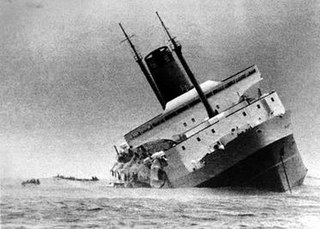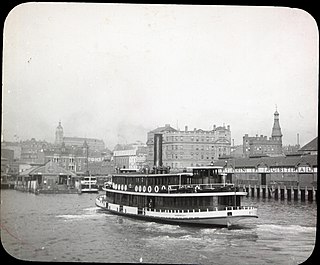
The ferry Rodney capsized and sank on Sydney Harbour 13 February 1938 with the loss of 19 lives. The ferry was carrying well-wishers and girlfriends of sailors on the heavy cruiser USS Louisville as it left the Harbour.

The ferry Rodney capsized and sank on Sydney Harbour 13 February 1938 with the loss of 19 lives. The ferry was carrying well-wishers and girlfriends of sailors on the heavy cruiser USS Louisville as it left the Harbour.

In the early twentieth century, Sydney Harbour had one of the largest ferry fleets in the world. However, the 1932 opening of the Sydney Harbour Bridge quickly saw annual patronage fall from a peak of 40 million passengers to 15 million. The largest operator, Sydney Ferries Limited, laid up in excess of a dozen vessels. Ferry operators sought new markets including excursion, concert, and spectator business. Smaller operators including Charles Rosman did quite well in this trade. Many of their smaller single deck ferries were fitted with rails and seating on their roofs for the enjoyment of passengers.
Rodney at the time was a new ferry, built in 1937 for the Rosman fleet. She was built by W L Holmes and Co of North Sydney. Her 80 hp Vivian diesel engines could push her to 8 knots. The wooden ferry was 16.9 m long, had a beam of 4.7 m and was 33 tons. She was licensed to carry 211 passengers, 60 upstairs and 151 on the main deck.
In January and February 1938, Louisville (CL/CA-28), a Northampton-class cruiser, undertook a Pacific goodwill tour which took her to Hawaii, Samoa, Australia, and Tahiti. In the harbour for 18 days, she was one of seven foreign warships in Sydney for the sesquicentenary of the arrival of the First Fleet at Sydney Cove.

On the afternoon of Sunday 13 February, thousands of Sydneysiders came to watch Louisville leave for Melbourne. The cruiser with 600 uniformed sailors lining the decks left her berth at Woolloomooloo with a band playing and onlookers cheering. She made her way towards Sydney Heads under the command of Captain Robert Mathewson. Among the scores of vessels following the cruiser down the harbour was Rodney, skippered by owner Charles Rosman, whose passengers had paid a shilling to see off the American cruiser. Rodney had 150 passengers on board, less than its total licensed limit of 211. However, as the ferry drew alongside Louisville, excited passengers rushed upstairs so that the upper deck was carrying about 100 passengers, well in excess of the upper deck's limit of 60, making the ferry top heavy.

Between Garden Island and Bradleys Head, Rodney passengers shouted to the skipper to take the ferry around to the cruiser's port side. As the ferry changed course to pass behind the stern of the larger ship, the crowd rushed over from small ferry's port side to the starboard side giving it a dangerous list. The shift in weight wobbled the ferry precariously in the wash of the Louisville, and Rodney began to capsize with passengers falling down the steeply sloping deck. Passengers spilled into the water and the boat rolled over and sank within a couple of minutes in 15 metres of water.
Passengers grabbed at floating seats or each other to stay afloat. Others had been knocked unconscious and drowned. Passengers on the lower inside deck who could not break windows to escape were taken down to the bottom with the ferry.

The police launch Cambrai carrying the police band, gave four sharp whistle blasts in a call for assistance. The Manly ferry, Barrenjoey and 20 launches were nearby and came to assist. 16 band members aboard the Cambrai jumped into the water to rescue those thrown from the ferry. Seven sailors from the Louisville dived from the cruiser before an order for action stations was called. Life jackets, four lifeboats and two motor launches were quickly lowered from the ship.

Louisville took 26 survivors on board, 18 of whom were unconscious and taken to the ship's hospital for treatment by a navy surgeon; all but one survived. The Cambrai's crew rescued 20 and bandsmen attempted resuscitation on its deck. A large motor cruiser, the Celere took on board 15.
Survivors were brought ashore at the Man O'War Steps, adjacent what is now the Sydney Opera House. 12 ambulances ferried 100 people to Sydney and St Vincent's hospitals.
Initially, police had thought 27 had died, however, before morning 8 of the missing had turned up. The final death toll was not confirmed until the ferry was raised from the bottom of the harbour and the bodies of seven of those trapped inside were recovered. 19 people died, of which 17 were women, one was a man and another a seven-year-old boy.
The Louisville continued to Melbourne that night. Two days later a ceremony was held on board and a wreath dropped at sea by the ship's seaplane. Some crew flew to Sydney the following Saturday to attend funeral services for victims.

After re-floating, Rodney was refitted and renamed Regis and returned to service. On 14 May 1938, the boat was repossessed by the mortgagee but rented by Rosman from June under the name Regis. [1]
On 1 May 1939, the High Court of Australia found that the vessel had capsized through negligence. Charles Rosman lost his captain's ticket for three years, although he ran his ferry business into the 1970s. Damages of £200 was awarded to one of the survivors, Laura Nagrint. As part of the ruling, the judge stated that if the fine was not paid within three weeks, the ferry would be put up for sale to cover the costs. [1] Regis was put up for auction by the High Court on 27 June but the highest bid of £1,500 was below the assessed value. [2]
Her name was changed again in 1939 to Regalia and she continued to serve in the Rosman Ferries fleet, moored at Mosman Bay through to the 1970s or 1980s. She was used on Botany Bay in the 1980s and in 2004 sank in the Georges River off Taren Point and broken up. [3] [4]

MS Herald of Free Enterprise was a roll-on/roll-off (RORO) ferry which capsized moments after leaving the Belgian port of Zeebrugge on the night of 6 March 1987, killing 193 passengers and crew.

TEV Wahine was a twin-screw, turbo-electric, roll-on/roll-off ferry. Ordered in 1964, the vessel was built by the Fairfield Shipbuilding and Engineering Company, in Govan, Glasgow, Scotland for the Union Steam Ship Company's Wellington-Lyttelton Steamer Express Service in New Zealand.

The Greycliffe disaster occurred in Sydney Harbour (Australia) on 3 November 1927 when the harbour ferry Greycliffe and the Union Steamship Company mail steamer Tahiti collided. The smaller ferry was cut in two and sank with the loss of 40 lives, the deadliest incident on Sydney Harbour.

MV Baragoola was a ferry formerly operated by the Port Jackson & Manly Steamship Company and its successors on the Manly service.
Sydney Ferries Limited operated ferry services on Sydney Harbour from 1900 until June 1951.

Bellubera was a ferry operated by the Port Jackson & Manly Steamship Company on the Manly service. Launched in 1910, she was the third of six "Binngarra-type" vessels. Upon her 1936 conversion from steam power, she became the first diesel-electric vessel in Australia. She was decommissioned in 1973, and scuttled at sea in 1980.
Rosman Ferries operates ferry services on Sydney Harbour.

Karrabee was a ferry operated by Sydney Ferries Limited and its NSW State Government operated successors on Sydney Harbour from 1913 until 1984. A wooden ferry built at the time of Sydney Ferries' rapid early twentieth century, she and near "sister", Karingal, were the smallest of the fleet of round-end "K-class ferries".

Kirawa was a ferry on Sydney Harbour. She was a near identical sister vessel with Kanangra both of which were launched in 1912 during the early-twentieth pre-Sydney Harbour Bridge boom years of Sydney Ferries Limited.

Koree was a "K-class" ferry on Sydney Harbour. Launched in 1902, the timber-hulled steamer was built for Sydney Ferries Limited during the boom in cross-harbour ferry travel prior to the opening of the Sydney Harbour Bridge.

The Kirrule-type ferries - Kiandra, Kirrule and Kubu - were three identical K-class ferries that operated on Sydney Harbour by Sydney Ferries Limited.

Kummulla was a "K-class" ferry on Sydney Harbour. Launched in 1903, the timber-hulled steamer was built for Sydney Ferries Limited during the boom in cross-harbour ferry travel prior to the opening of the Sydney Harbour Bridge. She was decommissioned in 1934 after the 1932 opening of the Bridge.

Wallaby was a ferry that operated on Sydney Harbour.

Kameruka and Kamiri were near identical ferries that served on Sydney Harbour. Kamiri was built in 1912 and Kameruka was launched on 8 February 1913. They were double-ended "K-class" steam ferries, a type that was prolific on Sydney Harbour in the early 20th century boom in cross-Sydney Harbour ferry transport before the 1932 opening of the Sydney Harbour Bridge. Kamiri was laid up in 1951 following the New South Wales government take-over of the Sydney Ferries Limited. Kameruka was converted to diesel in 1954 and was laid up in 1984.

Kareela was a "K-class" ferry on Sydney Harbour. Launched in 1905, the double-ended timber-hulled steamer was built for Sydney Ferries Limited in response to the early twentieth century boom in cross-harbour ferry travel prior to the opening of the Sydney Harbour Bridge. She was the first of Sydney Ferries Limited's boats to have a fully enclosed upper deck.

Sydney Harbour ferry services date back to the first years of Sydney's European settlement. Slow and sporadic boats ran along the Parramatta River from Sydney to Parramatta and served the agricultural settlements in between. By the mid-1830s, speculative ventures established regular services. From the late-nineteenth century the North Shore developed rapidly. A rail connection to Milsons Point took alighting ferry passengers up the North Shore line to Hornsby, New South Wales via North Sydney. Without a bridge connection, increasingly large fleets of steamers serviced the cross harbour routes and in the early twentieth century, Sydney Ferries Limited was the largest ferry operator in the world.

Kurraba and Kirribilli were two similar "K-class" ferries on Sydney Harbour. Launched in 1899 and 1900 respectively, the two timber-hulled steamers were built for Sydney Ferries Limited during the boom in cross-harbour ferry travel prior to the opening of the Sydney Harbour Bridge.

Kaludah was a K-class ferry on Sydney Harbour, Australia. Commissioned in 1909, the timber-hulled steamer was built for Sydney Ferries Limited during the boom in cross-harbour ferry travel prior to the 1932 opening of the Sydney Harbour Bridge. Like the other "K-class" ferries, she was double-deck, double-ended, steam-powered screw ferry. However, she and the larger but otherwise similar Kookooburra (1907), were the only two K-class ferries designed by naval architect Walter Reeks and not Sydney Ferries Limited's Captain Summerbell.

Karingal was a ferry operated by Sydney Ferries Limited and its NSW State Government operated successors on Sydney Harbour from 1913 until 1984. A wooden ferry built at the time of Sydney Ferries' rapid early twentieth century, she was the smallest of the round-end "K-class ferries".

Kanangra is a retired ferry on Sydney Harbour. She was launched in 1912 during the early-twentieth century pre-Sydney Harbour Bridge boom years of Sydney Ferries Limited.